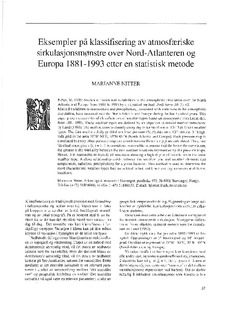Eksempler på klassifisering av atmosfæriske sirkulasjonsmønsstre over Nord-Atlanteren og Europa 1881-1993 etter en statistisk metode
Chapter, Peer reviewed
Permanent lenke
http://hdl.handle.net/11250/181504Utgivelsesdato
1995Metadata
Vis full innførselSamlinger
- AmS-Varia [57]
Originalversjon
Nitter, M. (1995) Eksempler på klassifisering av atmosfæriske sirkulasjonsmønsstre over Nord-Atlanteren og Europa 1881-1993 etter en statistisk metode. In Selsing, L (red.) Kilder for klimadata i Norden, fortrinnsvis i perioden 1860-1993. Stavanger : Arkeologisk museum i StavangerSammendrag
Marked variations in temperature and precipitation, associated with variations in the atmospheric circulation, have occurred over the North Atlantic and Europe during the last hundred years. This paper presents examples of classifications of weather types based on atmospheric circulation data from 1881-1993. These weather types are defined by an objective statistical method introduced by Lund (1963). The method aims to classify every day in terms of one of 10-15 different weather types. The data used are daily-gridded sea level pressure (SLP) data on a 10° latitude, 5° longitude grid in the area 70°W-50°E, 30°N-85°N (North Atlanti c and Europe). Each pressure map is correlated to every other pressure map and correlation coefficients r (i,j) are calculated . Thus, two identical maps give r (i,j) = 1. It is considered reasonable to assume that the better the correlation, the greater is the similarity between the two weather situations represented by the pressure maps. Hence, it is reasonable to include all situations showing a high degree of correlation in the same weather type. A close relationship exists between the weather type and weather elements (air temperature, radiation, precipitation) for a given location. This method is used to determine the most characteristic weather types that are related to hot, cold, wet and dry summers at different locations.
